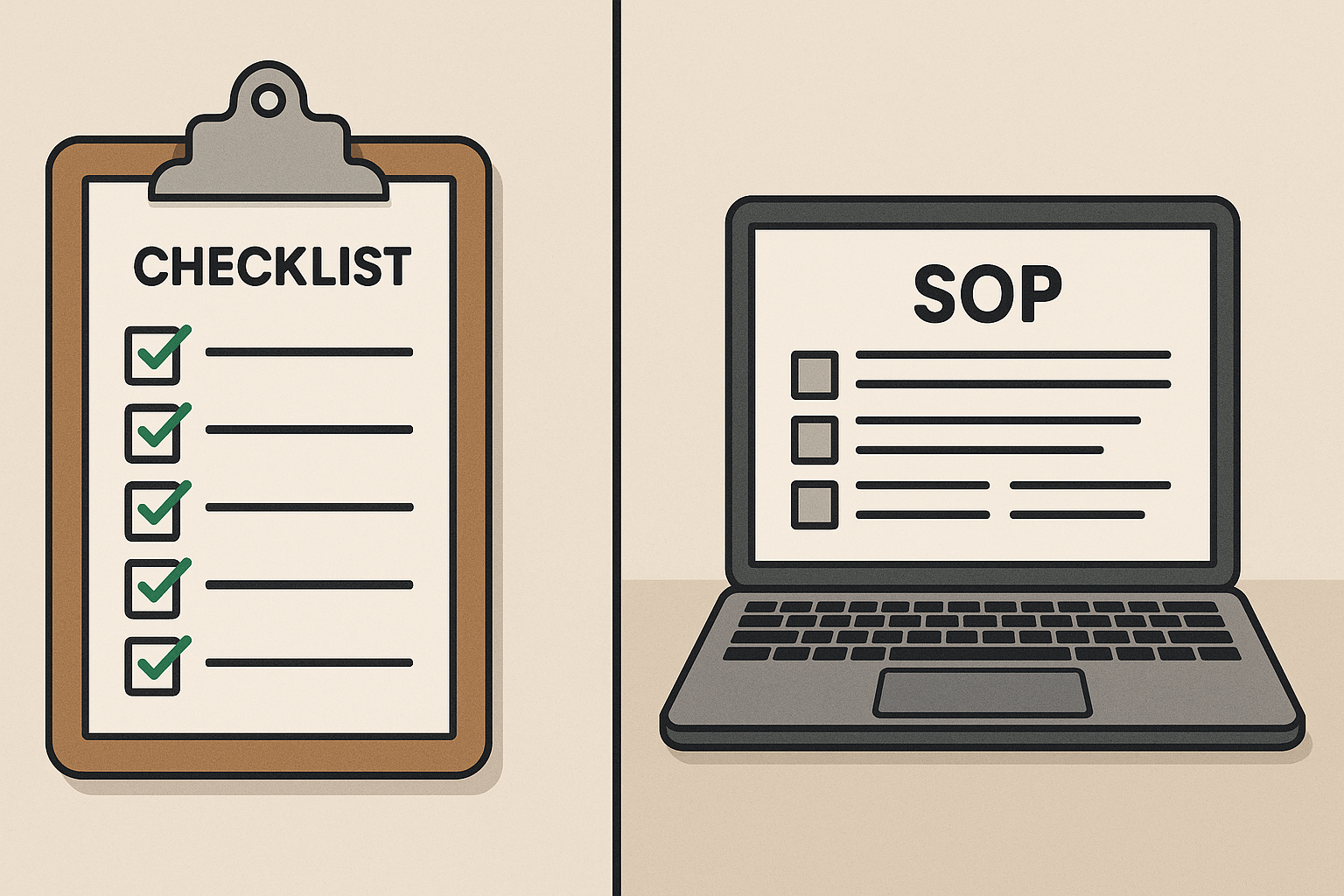Building a resilient, efficient business often comes down to how well your team executes tasks. In small businesses especially, every misstep counts. That’s why understanding the difference between a SOP vs checklist for small business operations is essential. Knowing when to use each tool—and when to use both—can make or break your team’s productivity.
Let’s break it down.
What Is an SOP?
A Standard Operating Procedure (SOP) is a detailed document that outlines how to complete a task or process from start to finish. SOPs cover the “what,” “why,” and “how” — ensuring consistency, quality, and accountability.
Key characteristics of an SOP:
- Step-by-step instructions
- Context and background information
- Required tools, systems, or permissions
- Clear ownership and escalation paths
Example: A small marketing agency’s SOP for onboarding new clients includes detailed steps for initial meetings, document collection, CRM updates, and welcome emails.
What Is a Checklist?
A checklist is a simple, often one-page list of tasks that need to be completed. It serves as a quick reminder, ensuring that no steps are missed in a repeatable process.
Key characteristics of a checklist:
- Bullet points or short phrases
- Focus on task completion, not instructions
- Designed for speed and consistency
Example: A checklist for closing the office at night: lock doors, turn off lights, set alarm.
Pros and Cons of SOPs
Pros
- Consistency: Ensures tasks are done the same way every time.
- Training aid: New hires ramp up faster.
- Risk mitigation: Reduces errors and compliance issues.
Cons
- Time-consuming to create: Building comprehensive SOPs requires an upfront investment.
- Can become outdated: Without regular reviews, they may no longer reflect best practices.
Pros and Cons of Checklists
Pros
- Fast to create and update: Quick to draft and adjust.
- Boosts memory recall: Helps teams complete multi-step tasks reliably.
- Easy to adopt: No heavy training needed.
Cons
- Lacks depth: Doesn’t explain “how” or “why.”
- Not ideal for complex processes: Only suited for straightforward or well-understood tasks.
When to Use an SOP
Use an SOP when:
- Tasks are complex or involve multiple decision points.
- Mistakes have significant consequences (e.g., legal, financial, brand reputation).
- You are training new employees on an unfamiliar process.
- The process requires compliance with regulations.
Example SOP use cases:
- Client onboarding workflows
- Financial reporting processes
- Emergency response procedures
Need help structuring your processes? Explore our Business Planning Services for expert guidance.
When to Use a Checklist
Use a checklist when:
- The task is routine but still critical.
- The user already knows how to perform the task but benefits from reminders.
- You want a quick reference tool without overwhelming detail.
Example checklist use cases:
- Monthly social media post approvals
- Office opening and closing procedures
- Equipment maintenance checks
Can You Use Both Together?
Absolutely. In fact, many smart teams do. Think of an SOP as your “instruction manual” and a checklist as the “summary page” you can reference at a glance.
Hybrid strategy:
- Train with SOPs to build deep understanding.
- Work with checklists to ensure daily consistency.
Example: A small ecommerce business uses an SOP to train new employees on packaging orders, then gives them a simple checklist taped to the workstation for quick daily use.
Quick Tips for Small Teams
- Start simple: Build checklists for immediate wins while gradually drafting full SOPs for complex processes.
- Prioritize high-risk areas: Document procedures where mistakes are costly first.
- Schedule regular reviews: Set quarterly reminders to update SOPs and checklists.
- Make documents accessible: Use shared drives or project management tools like Notion or Asana.
For more advice on scaling your operations effectively, check out our Operations Consulting Services.
Ready to bring clarity and structure to your business? Schedule a free discovery call →

